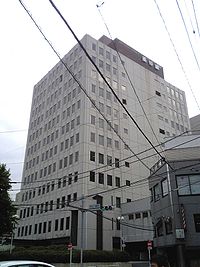Kumagai Gumi Co., Ltd.(Kabushiki gaisha hùng cốc tổ,Kabushiki-gaisha Kumagai Gumi)is a Japanese construction company founded inFukui,Fukui Prefecture,Japan.The company still has registered headquarters in Fukui, but the actual head office is located inShinjuku,Tokyo.
 | |
 Kumagai Gumi headquarters in Tokyo | |
Native name | Kabushiki gaisha hùng cốc tổ |
|---|---|
| Company type | Public(K.K) |
| TYO:1861 | |
| ISIN | JP3266800006 |
| Industry | Construction Engineering |
| Founded | (January 1898, 01) inFukui, Japan |
| Founder | Santaro Kumagai |
| Headquarters | Shinjuku-ku, Tokyo 162-8557 ,Japan |
Area served | Worldwide |
Key people | Yasushi Higuchi (President) |
| Products |
|
| Services |
|
| Revenue | |
Number of employees | 3,798 (as of March 31, 2016) |
| Website | Official website |
| Footnotes / references [1][2] | |
History
editSantaro Kumagai, the company's founder, began his career as a civil servant in a police department. His construction career started as a stonemason, crafting religious monuments and performing work for the expanding railway network.[3]
Kumagai founded his own company in 1898 and incorporated it in 1938. Between 1955 and 1983 the company accounted for more than 10% of all contracts awarded to the fifty-seven members of the Overseas Construction Association of Japan, a figure that outranked the ‘Big Five’ domestic giant construction companies.[4]As overseas projects were riskier, these five companies were reluctant to expand beyond Japan. Kumagai Gumi took advantage of the situation and sought work overseas, as both as a construction company and a developer, usingBOTas project financing, becoming one of the leading proponents of BOT in Southeast Asia. By 1985 overseas earnings amounted to 46% of Kumagai's total contracts.[5]
In the 1980s the company became the largest Japanese real estate investor inNew York City,[6]investing in projects in Manhattan, including in projects developed byWilliam Zeckendorf Jr.[7]
Major works
editDams and railways
edit- Tokuyama Dam-Ibigawa
- Mass Transit Railway-Hong Kong(numerous contracts)
- Delhi Metro Yellow line-Delhi[8]
- Taipei Metro Bannan Line-Taipei[9]
- Bangkok Metropolitan Rapid Transit Blue Line-Bangkok[9]
- North East MRT line-Singapore[10]
- East–West MRT lineChangi Airport branch - Singapore
- Marmaray rail link-Istanbul[11]
- Skitube Alpine Railway-Sydney[12]
Tunnels
edit- Water tunnel atPlover Cove- New Territories, Hong Kong[13]
- Modified Initial System (section between Admiralty and Tsim Sha Tsui stations)- Victoria City and Kowloon, Hong Kong[13]
- Seikan Tunnel- Aomori and Hakodate[13]
- Eastern Harbour Crossing- Hong Kong[3][13]
- Sydney Harbour Tunnel- Sydney[14]
- Western Harbour Crossing- Hong Kong[13]
- Eagle's Nest Tunnel- Hong Kong[15]
Skyscrapers
edit- Taipei 101- Taipei[16]
- Bank of China Tower- Hong Kong[17]
- Shun Hing Square-Shenzhen[18]
- CITIC Plaza-Guangzhou[19]
- Dayabumi Complex-Kuala Lumpur
- Bank of China Tower-Shanghai
- Melbourne Central-Melbourne
Hotels
editReferences
edit- ^"Corporate Profile".Kumagai Gumi. Archived fromthe originalon 9 December 2017.Retrieved30 August2017.
- ^"Company Profile".Nikkei Asian Review.Nikkei Inc.Retrieved30 August2017.
- ^abLevy, Sidney M. (27 September 1996).Build, Operate, Transfer: Paving the Way for Tomorrow's Infrastructure.John Wiley & Sons.pp.286–287.ISBN978-0-471-11992-0.
- ^Rimmer, Peter J. (1 March 1990). "The Internationalisation of the Japanese Construction Industry: The Rise and Rise of Kumagai Gumi".Environment and Planning A.22(3):345–368.doi:10.1068/a220345.S2CID143137111.
- ^Smith, Michael P. (1 January 1989).Pacific Rim Cities in the World Economy.Transaction Publishers.p.180.ISBN978-1-4128-3042-3.
- ^Levy, Sidney M. (6 December 2012).Japanese Construction: An American Perspective.Springer Science & Business Media. p. 5.ISBN978-1-4684-6665-2.
- ^Lyons, Richard D. (13 July 1986)."The Zeckendorf Flag Flying High Again".The New York Times.Retrieved31 August2017.
- ^Zubko, Katherine C.; Sahay, Raj R. (16 September 2010).Inside the Indian Business Mind: A Tactical Guide for Managers: A Tactical Guide for Managers.ABC-CLIO.p. 13.ISBN978-0-313-37830-0.
- ^abMesse München(1 January 1998).Tunnel Construction.CRC Press.pp.73–81.ISBN978-90-5410-951-8.
- ^"Singapore gets its first semi".New Civil Engineer.1 August 1999.Retrieved4 June2024.
- ^Brunn, Stanley D. (19 March 2011).Engineering Earth: The Impacts of Megaengineering Projects.Springer Science & Business Media.p. 727.ISBN978-90-481-9920-4.
- ^Geoffrey B Churchman (1995).Railway Electrification in Australia and New Zealand.IPL Books.ISBN0-646-06893-8
- ^abcde"Giant shapes HK".23 December 1993.
- ^Levy, Sidney M. (6 December 2012).Japanese Construction: An American Perspective.Springer Science+Business Media.p. 131.ISBN978-1-4684-6665-2.
- ^World Highways.Route One Publishing. 2004.
- ^Binder, Georges (2006).101 of the World's Tallest Buildings.Images Publishing. p. 27.ISBN978-1-86470-173-9.
- ^Binder, Georges (2006).101 of the World's Tallest Buildings.Images Publishing. p. 47.ISBN978-1-86470-173-9.
- ^Binder, Georges (2006).101 of the World's Tallest Buildings.Images Publishing. p. 41.ISBN978-1-86470-173-9.
- ^Binder, Georges (2006).101 of the World's Tallest Buildings.Images Publishing. p. 39.ISBN978-1-86470-173-9.
External links
edit- (in English)Kumagai GumiArchived7 November 2018 at theWayback Machine
- (in Japanese)Kumagai Gumi